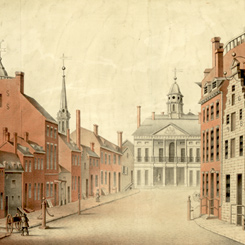 Image courtesy of Library of Congress
The first session of the 1st Congress (1789–1791) met at Federal Hall in New York City. In December 1789, Congress moved to Philadelphia.
Image courtesy of Library of Congress
The first session of the 1st Congress (1789–1791) met at Federal Hall in New York City. In December 1789, Congress moved to Philadelphia.
On this date, the
First Congress (1789–1791) met for a Saturday session. The House did not achieve its first quorum until April 1, 1789 (nearly a month after the session began), but once official business started, the House proceeded with a flurry of activity. That Saturday, Representative
Joshua Seney of Maryland introduced a measure giving the U.S. ten square miles of whatever land it wanted in Maryland to use as “the seat of the Federal Government.” The House also debated levying a duty on goods imported into the United States. Members sought to demonstrate the new federal Congress’s power (relative to its ineffective predecessor, the Continental Congress) by tackling an ambitious agenda that required six-day work weeks. A constituent of
George Thatcher of Massachusetts wrote the new Congressman to complain about the length of the sessions and the financial cost to the country. Thatcher responded by explaining that after the ratification of the Constitution the pressing business of the country required Congress to stay in session. Modern Congresses rarely meet on Saturdays for legislative business, but the typical congressional session lasts longer than it did in the 18th and 19th centuries.
 Image courtesy of Library of Congress
The first session of the 1st Congress (1789–1791) met at Federal Hall in New York City. In December 1789, Congress moved to Philadelphia.
Image courtesy of Library of Congress
The first session of the 1st Congress (1789–1791) met at Federal Hall in New York City. In December 1789, Congress moved to Philadelphia.








